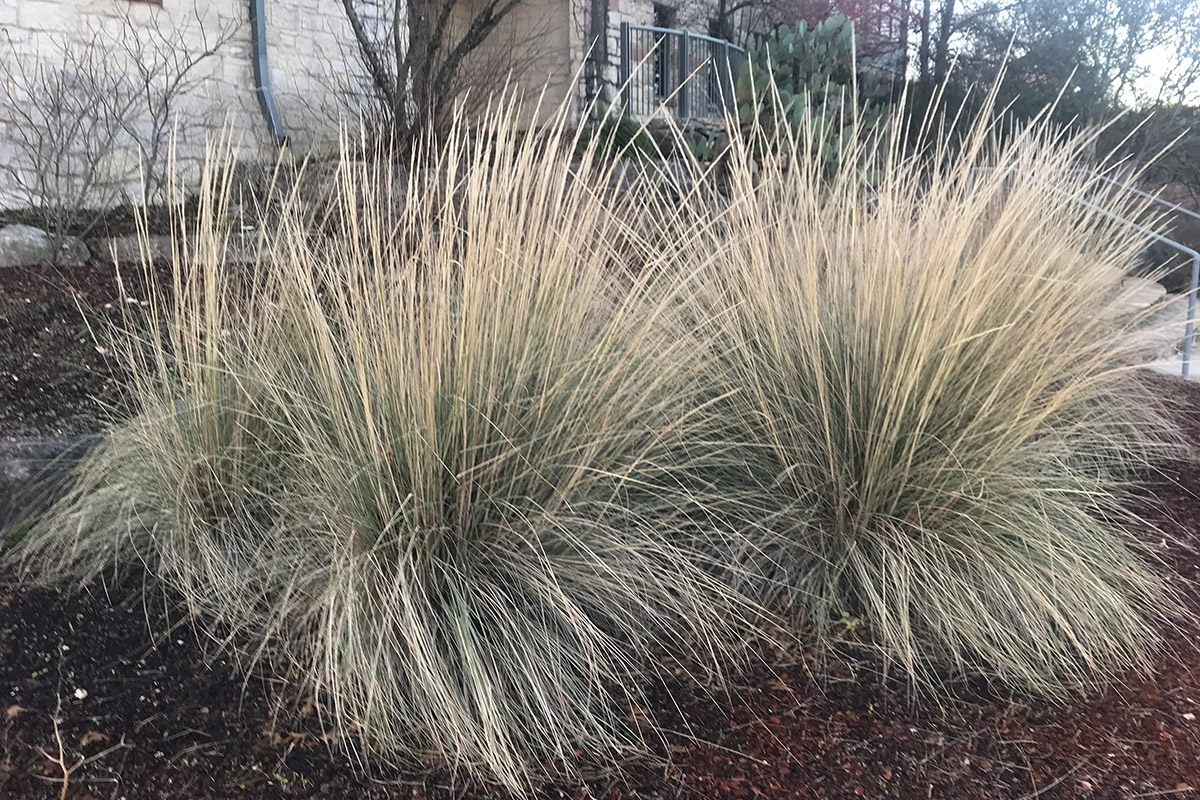
I’m a big fan of using muhly grasses (Muhlenbergia spp. and cvs., Zones 5–11) in Southern Plains gardens. They are native to our region, and their size and salient features vary by species. They are drought tolerant, easy to establish, and require little care. What care they do require is generally limited to a yearly grooming. I often have folks ask me if they should cut back their muhlies and, if not, then what they should do with them instead. Here are some species-specific instructions on how to groom your muhly grasses so that they perform their best.

Big muhly
The largest and stateliest of muhlies is the big muhly (M. lindheimeri, Zones 7–10), also known as Lindheimer muhly. This muhly requires the most maintenance simply due to the volume of foliage produced and the tall, stiff flower stalks. My favorite way to manage big muhlies is to burn them to the ground in a prescribed burn every other year, usually in midwinter. At the botanical garden where I used to work, we did this using trained wildland firefighting personnel and specialized equipment. While burning them is not safe or practical for homeowners, I mention it here for those larger landowners who may have an opportunity to host a prescribed, officiated burn on their property and are wondering how big muhly responds.

My second-favorite way to groom big muhlies is by hand with a rake in midwinter. First, I reach into the center of the clump and break off all the tall flower stalks. Then I use an adjustable garden rake to rake upward from the base, removing dead leaves as I go. Because big muhlies are large and tough, this can be a pretty tiring job, and it usually takes me about 20 minutes per plant to do it correctly. However, it removes a lot of dead material and leaves the plant ready for a fresh flush of spring growth.
At this point you may be wondering, “Why doesn’t she just cut them to the ground in winter and let them resprout in the spring?” The answer to this is twofold: First, cutting them down leaves them susceptible to rot. Rain that falls on the stubby clump and accumulates at the base can rot out the whole plant. Second, it looks pretty ugly. It is quite common to see landscapers cut big muhlies down to stubby pincushions at the end of summer, where they remain as dead-looking things until spring. It’s an ugly treatment, and landscapers often cut them down before the plants get a chance to show off their beautiful winter foliage.

Pink muhly
Pink muhly (M. capillaris, Zones 6–10), also known as gulf muhly, is easier to manage than big muhly simply because it is smaller, the foliage is softer, and the flower stalks are not as stiff and difficult. While I have tried burning pink muhlies in the past, I generally don’t do it anymore because they are more sensitive to fire than big muhlies and don’t need such a drastic treatment. Pink muhly simply needs a good raking at the end of winter to keep it looking good. As with big muhly, use an adjustable garden rake and rake the foliage upward from the base. (If you rake downward, it will end up looking rather flat and deflated.) Pink muhly doesn’t need any specific attention for flower stalk removal.

Pine muhly and bull grass
Pine muhly (M. dubia, Zones 7–10) and bull grass, or deer muhly (M. emersleyi, Zones 6–9), can be managed like pink muhly, with a good upward raking at the end of winter. Pine muhly is much like a smaller big muhly and may need to have its stiff flower stalks broken off by hand.

Seep muhly
I often choose not to groom seep muhly (M. reverchonii, Zones 5–10) at all. This muhly grows in small, distinct clumps of wiry-haired grass. The curly, wiry mass of grass is what gives it its charm, and I usually choose not to intervene. It can accumulate dead matter at its base, and so you may choose to carefully remove some of this matter with your hands (finger-raking is good) or a small hand rake.

Nimblewill
Nimblewill (M. schreberi, Zones 6–11) is a muhly too! This grass doesn’t form clumps but rather spreads along the ground and reaches a height of about 12 inches. You can rake nimblewill with a garden rake or even groom it with a wide-toothed hair comb. It’s easy to manage, and you can trim it up whenever it gets too unruly. When that happens, I take the pruners to it and give it a haircut.
No matter how you selectively prune your muhly grasses, be aware of your timing. These grasses look amazing in the wintertime, with their foliage adding visual interest and their seed heads providing food for wildlife. Leave them standing through the winter and you won’t be sorry. I wait until mid to late winter to give them their annual grooming, with the exception of nimblewill, which you can groom year-round. To learn more about muhlies, read Magnificent Muhly Grasses.
—Karen Beaty is a forestry specialist at the city of Austin’s Wildland Conservation Division.


















Comments
Log in or create an account to post a comment.
Sign up Log in